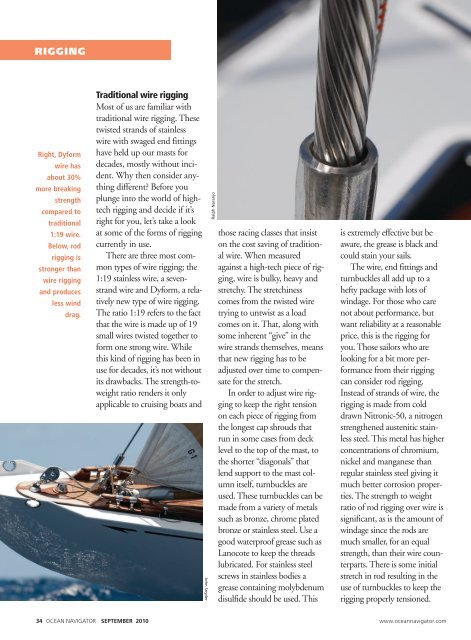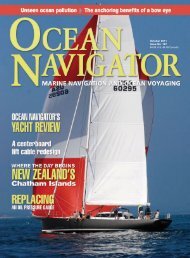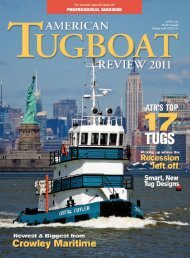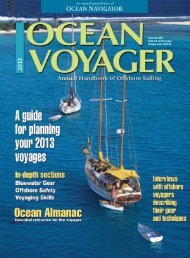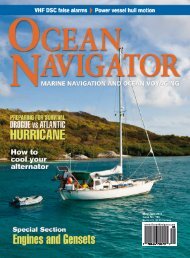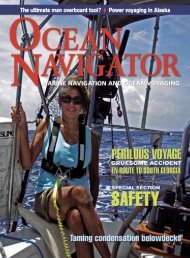Ask For A Test Demo - Navigator Publishing
Ask For A Test Demo - Navigator Publishing
Ask For A Test Demo - Navigator Publishing
You also want an ePaper? Increase the reach of your titles
YUMPU automatically turns print PDFs into web optimized ePapers that Google loves.
RIGGINGRight, Dyformwire hasabout 30%more breakingstrengthcompared totraditional1:19 wire.Below, rodrigging isstronger thanwire riggingand producesless winddrag.Traditional wire riggingMost of us are familiar withtraditional wire rigging. Thesetwisted strands of stainlesswire with swaged end fittingshave held up our masts fordecades, mostly without incident.Why then consider anythingdifferent? Before youplunge into the world of hightechrigging and decide if it’sright for you, let’s take a lookat some of the forms of riggingcurrently in use.There are three most commontypes of wire rigging; the1:19 stainless wire, a sevenstrandwire and Dyform, a relativelynew type of wire rigging.The ratio 1:19 refers to the factthat the wire is made up of 19small wires twisted together toform one strong wire. Whilethis kind of rigging has been inuse for decades, it’s not withoutits drawbacks. The strength-toweightratio renders it onlyapplicable to cruising boats andJohn SnyderRalph Naranjothose racing classes that insiston the cost saving of traditionalwire. When measuredagainst a high-tech piece of rigging,wire is bulky, heavy andstretchy. The stretchinesscomes from the twisted wiretrying to untwist as a loadcomes on it. That, along withsome inherent “give” in thewire strands themselves, meansthat new rigging has to beadjusted over time to compensatefor the stretch.In order to adjust wire riggingto keep the right tensionon each piece of rigging fromthe longest cap shrouds thatrun in some cases from decklevel to the top of the mast, tothe shorter “diagonals” thatlend support to the mast columnitself, turnbuckles areused. These turnbuckles can bemade from a variety of metalssuch as bronze, chrome platedbronze or stainless steel. Use agood waterproof grease such asLanocote to keep the threadslubricated. <strong>For</strong> stainless steelscrews in stainless bodies agrease containing molybdenumdisulfide should be used. Thisis extremely effective but beaware, the grease is black andcould stain your sails.The wire, end fittings andturnbuckles all add up to ahefty package with lots ofwindage. <strong>For</strong> those who carenot about performance, butwant reliability at a reasonableprice, this is the rigging foryou. Those sailors who arelooking for a bit more performancefrom their riggingcan consider rod rigging.Instead of strands of wire, therigging is made from colddrawn Nitronic-50, a nitrogenstrengthened austenitic stainlesssteel. This metal has higherconcentrations of chromium,nickel and manganese thanregular stainless steel giving itmuch better corrosion properties.The strength to weightratio of rod rigging over wire issignificant, as is the amount ofwindage since the rods aremuch smaller, for an equalstrength, than their wire counterparts.There is some initialstretch in rod resulting in theuse of turnbuckles to keep therigging properly tensioned.34 OCEAN NAVIGATOR SEPTEMBER 2010www.oceannavigator.com


